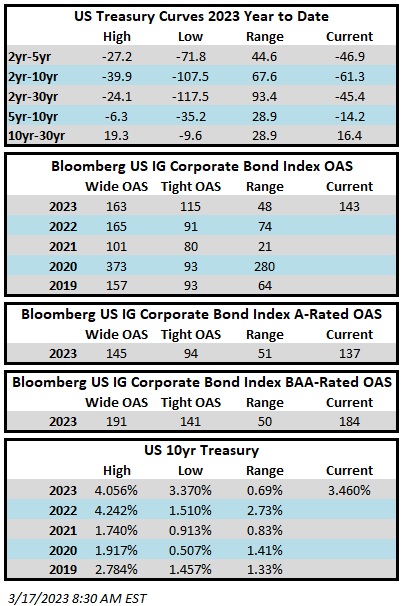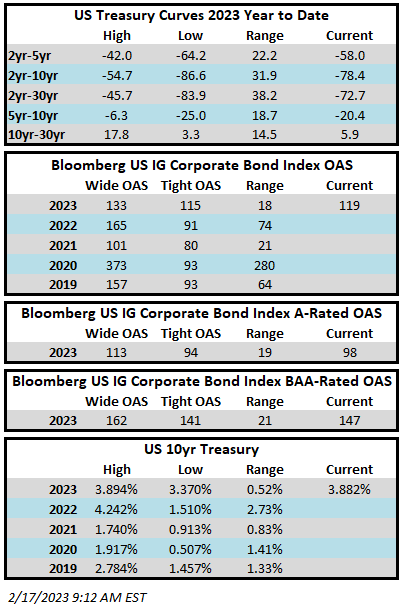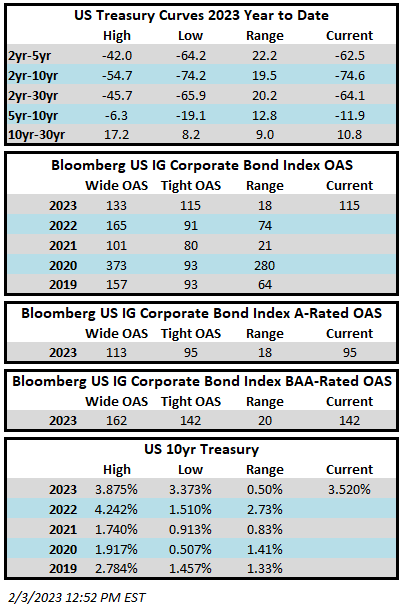Fund Flows & Issuance: According to a Wells Fargo report, flows week to date were -$1.9 billion and year to date flows stand at -$12.6 billion. New issuance for the week was nil and year to date issuance is at $38.5 billion.
(Bloomberg) High Yield Market Highlights
- The turmoil in the US regional banking industry and the near-collapse of the Swiss bank Credit Suisse Group AG caused investors to spurn risk and pull funds out of the asset class. CCCs, the riskiest segment of the US junk bond market, were headed toward the biggest weekly loss since September of last year. The week-to-date losses in CCCs stood at 1.76% as spreads moved to the distress zone and closed at +1,014bps. The upheaval caused by fears of contagion in the banking sector and renewed concerns about Fed rate decisions in the upcoming meeting brought the primary market to a screeching halt.
- The consumer price index, excluding food and energy, increased 0.5% last month according to a report on Tuesday. That’s the most in five months, forcing the Fed to consider pressing its inflation fight even while mending the regional banking industry.
- Moody’s expects the Federal Reserve to raise the federal funds rate by 25bps at its March 22 meeting, Madhavi Bokil wrote on Wednesday.
- “Broader tightening of bank lending conditions will factor into decisions as to how high the rate should go to bring down inflation,” she wrote.
- The tumult with Credit Suisse seems to have stopped on Thursday, after the firm opened a 50 billion Swiss franc ($54 billion) credit line with the Swiss National Bank.
- But Credit Suisse came soon after the collapse of regional US lenders including Silicon Valley Bank late last week and Signature Bank this week fueling concerns about financial stability.
- Yields surged to 9% for the first time this year, and spreads breached the +500 level for the first time since October but calmed down after interventions and closed at 8.93% and +485bps, respectively.
- Junk bonds rebounded across the board on Thursday. The broader high yield index posted modest gains 0.41%. But it is headed toward second straight week of losses. The week-to-date losses are 0.28%.
- Elevated volatility, continuing uncertainty about economic growth, concerns about sticky inflation and the pace of rate hikes have kept junk bond borrowers on the sidelines.
(Bloomberg) Dash for Cash by Banks Fuels Signs of Tension in Funding Markets
- There are some signs of increased pressure within US dollar funding markets as fears grow around the outlook for the banks and the turmoil drives lenders to shore up their own cash buffers.
- With global financial markets reeling in the wake of Silicon Valley Bank’s bank-run-fueled failure last week, worries about the future of Credit Suisse Group AG have amped up global concern. That sent short-end debt-market rates plummeting again Wednesday as investors radically shifted their outlook for central bank policy and flocked to haven assets.
- Dollars continue to flow through the pipes of the interbank lending system, but there are indications that the cost of funding is ticking up and that institutions are taking the precaution of building up their cash piles.
- Rates on overnight repurchase agreements moved higher for a period on Wednesday, pointing to stronger demand and general jitteriness. And a number of other market indicators, including the gap between forward-rate agreements and overnight index swaps, are also indicating heightened tension. Activity around the Federal Home Loan Banks system in recent days is suggestive of banks looking to ensure they have enough cash.
- Here are some of the funding-market indicators to look at for signs of pressure.
- The rate on repurchase agreements for US dollars, a key funding market, moved higher Wednesday. The general collateral overnight repo rate first traded with a bid-ask spread of 4.67%/4.66%, according to ICAP. That compares with around 4.45% at the end of Tuesday.
- “If we do start to see a broad based increase in repo rates that will get the market and perhaps the Fed more concerned about the overall health of the banking system,” BMO Capital Markets Strategist Ian Lyngen said in a phone interview.
- The gap between direct forward-rate agreements and index-tied ones — often used as a measure of the difficulty banks have in getting access to funds — has swelled. It this week moved to levels last seen around the early stages of the Covid pandemic in 2020.
- The Federal Home Loan Banks system, which provides funding to commercial banks and other members via so-called advances, has been increasing the amount of funds it has on hand, suggesting that it has seen a dramatic uptick in demand for dollars. In an unusual move, the FHLBs on Monday raised an unprecedented $88.7 billion through floating-rate notes, followed by another $19 billion on Tuesday. It has also raised some $22.87 billion via term discount notes and has overnight funding on top of that, which reached $67.55 billion on Monday.
- The total amount of advances to members, which is published quarterly, had already more than doubled to $819 billion last year as increased Fed interest rates helped put pressure on deposits and this latest episode may push them higher still.
- Another sign of the FHLBs needing to filter more money to its members is in its apparent pullback from the fed funds market. It’s the biggest player in that market, a place it tends to park its extra cash, so a pullback in fed funds activity — as has been witnessed this week — is indicative of the FHLBs channeling more money to other places.
- One area that market participants will be keeping a keen eye on is the usage of various official backstop facilities from the Fed. This past weekend saw US authorities introduce a new backstop for banks, the Bank Term Funding Program. Borrowing from the emergency bank facility will be disclosed each Thursday in the Fed’s regular balance sheet update, but individual borrowers won’t be named for two years.
This information is intended solely to report on investment strategies identified by Cincinnati Asset Management. Opinions and estimates offered constitute our judgment and are subject to change without notice, as are statements of financial market trends, which are based on current market conditions. This material is not intended as an offer or solicitation to buy, hold or sell any financial instrument. Fixed income securities may be sensitive to prevailing interest rates. When rates rise the value generally declines. Past performance is not a guarantee of future results.



